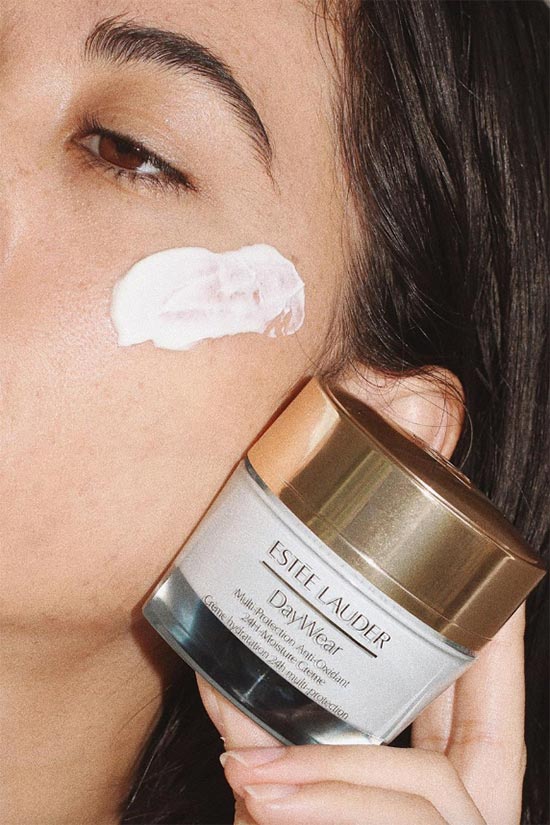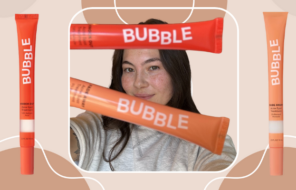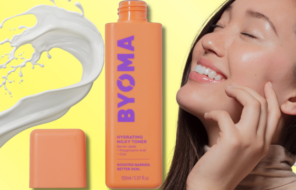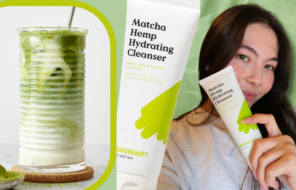Dry skin can get tight and itchy at the drop of a hat, and it is so easy to overdo it with the powder and end up with cakey-looking makeup. With that being said, there are benefits, like nearly invisible pores and a smaller likelihood of breaking out with acne bumps. A good skincare routine is often enough to mitigate the bad parts of dry skin, so today, I’ll help you sort that out.
The best way to be able to treat your dry skin is by understanding it, so I explain exactly what it is and what its characteristics are. I talk a bit about the causes of dry skin and explain the difference between dryness and dehydration. I explain how you can improve the look and feel of your dry skin by talking about the best ingredients as well as by giving a comprehensive dry skincare routine guide.
In this article:
- What Is Dry Skin?
- Dry Skin Symptoms
- Causes of Dry Skin
- Dry Skin vs. Dehydrated Skin: What’s the Difference?
- Dry Skin Treatment Tips: How to Improve Dry Skin Best
- Skincare Ingredients for Dry Skin
- The Complete Morning Skincare Routine for Dry Skin
- The Complete Night Skincare Routine for Dry Skin
- Weekly Skincare Routine for Dry Skin
What Is Dry Skin?
To keep things simple, dry skin is skin that doesn’t produce a ton of sebum, which is, in simplified terms, human facial oil. Sebum is a very important part of healthy skin functioning. It helps improve our skin’s barrier capabilities by filling in gaps between the cells of the stratum corneum, providing antioxidant protection, and keeping water in the skin.
Because of this, those who have dry skin are more likely to end up with a compromised skin barrier. This results in all kinds of issues, with the chief one being increased sensitivity with redness, inflammation, and stinging as its frequent companions. Other concerns include a tight, uncomfortable feeling due to dehydration, flakiness and dead skin cell build-up, and a dull, overly matte appearance.
Dry Skin Symptoms
How do you know if you have dry skin? Watch these symptoms!
• Lack of Facial Oils
This first point could easily be the only point in this category, as lack of oil production (or sebum production if we’re getting all technical) is the main characteristic of dry skin. If your skin only gets shiny on the hottest days or with the help of copious amounts of strobe cream, and if you have no idea what “feeling greasy” means then you can assume that your skin is probably dry.

• Smaller Pores
While this may not be true across the board, for the most part those who have dry skin have smaller pores. The exception lies with skin that has undergone serious levels of stress, as well as with people who had oily skin in their youth that later on became dry either due to age or medication. In those instances, the pores may stretch out and never tighten back up.
• Likelier to Look Dull and Matte
As a side effect of reduced oil production, dry skin will look pretty matte and dull by default. A good moisturizer or two is usually all it takes to return some luminosity to the skin, so this really only applies to untreated or compromised dry skin.
• Propensity to Dehydration
A propensity to dehydration is another side effect of low sebum production. The natural oils our skin produces help prevent moisture loss from the skin, so when we don’t have enough of them our skin can become dehydrated much more quickly.
Dehydrated skin looks dull and will feel tight and uncomfortable. Dehydrated skin is also much more prone to damage, irritation, and infection. Those with dry skin who maintain a good skincare regimen while drinking enough will avoid this issue.
• Propensity to Flakiness
Flakey skin that usually crops up when dead skin starts to build up more thickly than usual or is unable to shed itself for whatever reason (the shedding process, by the way, is called desquamation). This can happen with any skin type, but it is more common with dry skin.
This is because the lipids in our sebum aid with the desquamation process, so when the skin lacks sebum desquamation can be disrupted. A mixture of gentle exfoliation and moisturization with skin identical ingredients will usually help prevent and get rid of flaky dead skin.
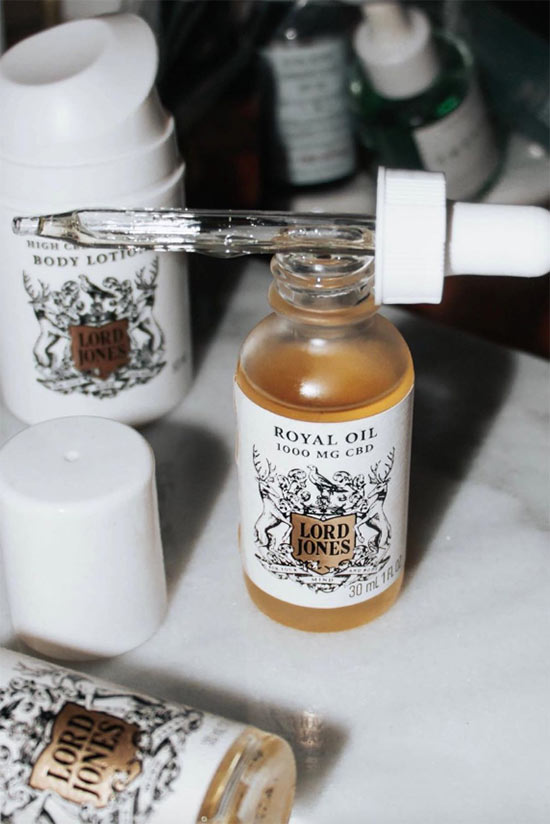
• Prone to Irritation and Sensitivity
Our sebum acts like glue that fills in the gaps between the dead skin cells that make up the stratum corneum. By filling in the gaps it makes the skin stronger and prevents pathogens from getting into it and wreaking havoc.
Since dry skin lacks sebum, the skin can become more sensitive and prone to irritation caused by outside pathogens and irritants. This sensitivity can manifest as redness, swelling, stinging, or itchiness depending on the cause and type of reaction.
The best way to prevent a negative reaction is to keep the skin fortified with rich yet gentle moisturizers, while the best way to calm down a reaction is with serums or lotions that contain anti-inflammatory ingredients.
• Less Prone, but Not Immune, to Breakouts
The greatest benefit of having dry skin, especially when it’s well taken care of, is that you’re less likely to develop acne. This is because overproduction of sebum is one of the factors in the formation of breakouts, and with that factor gone, your skin will usually remain clear.
That being said, some people with dry skin still break out, either due to hormonal issues or as a side effect of having a compromised skin barrier. Treating acne when you have dry skin can be a little more complicated than it would for those with oily skin, because while the same anti-acne treatments will certainly help, they have to be formulated in very nourishing formulas, which are harder to find.
Causes of Dry Skin
Dry skin, to put it plain and simple, is caused by reduced oil gland activity in the skin. In our skin, connected to our hair follicles, we all have the tiny sebaceous glands that are responsible for making sebum. We have them in the skin all over our bodies, with the exception of the palms of the hands and soles of the feet. While all people have around the same number of sebaceous glands, some have sebaceous glands that produce more oil than others.
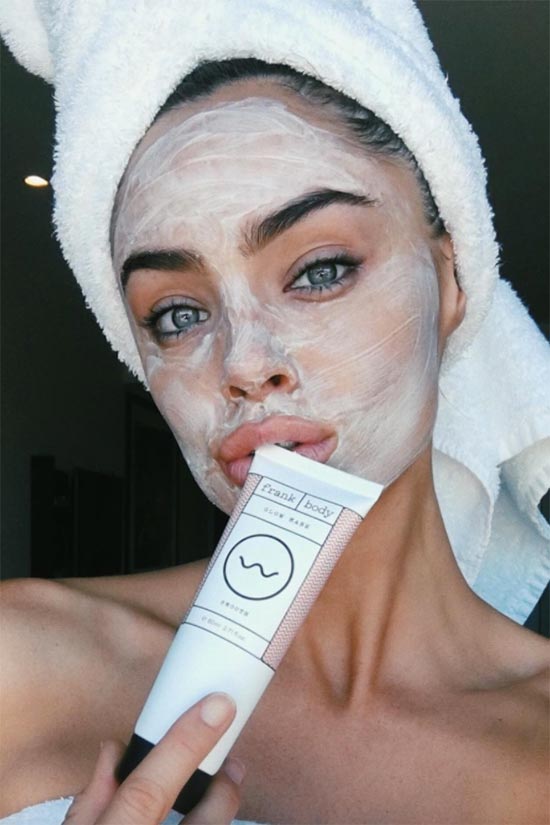
Sebum production is very strongly linked to androgen hormones, so as our hormones fluctuate throughout our lives, so will our oil production. For women, the skin normally gets oilier in the teen years and then becomes drier when androgen production decreases towards menopause. Mature skin tends to be drier while younger skin tends to be oilier, but of course, exceptions abound.
There are also certain medications that will cause dry skin. One such example is isotretinoin (more commonly known by its former brand name, Accutane), the nuclear bomb of acne medication. Those who take isotretinoin often start out with very oily, acne-prone skin, but the medication inhibits sebaceous gland activity to the point that the skin does a 180 and becomes very dry. Certain skin conditions, including dermatitis, rosacea, and psoriasis can lead to dry skin either only in patches of skin over the body or all over.
For many people, the various symptoms of having dry skin can worsen over the winter when the air lacks humidity and everyone becomes more prone to dehydration. That is why a lot of people will have a richer, more nourishing skincare routine in the wintertime and in fall but in the summertime, they will scale back.
Dry Skin vs. Dehydrated Skin: What’s the Difference?
Dry skin refers to skin that doesn’t produce a lot of facial oils, while dehydrated skin refers to skin that is lacking in water content. The two terms often get confused, but it’s actually very important to know the difference.
As I already explained, dry skin is a skin type. It is something that will not change through skin care since the way the oil glands behave is biological. You can use skin care to mitigate some of the downsides of having dry skin, but you can’t trick your glands into producing more oil. Dehydration, on the other hand, is a skin concern. It is a momentary issue that good skin care can absolutely fix.
The sebum our skin produces does help to trap moisture into the skin, so if your skin doesn’t produce enough you will be more prone to dehydration. Those with dry skin are more prone to dehydration, so dehydration can be considered a potential symptom of having dry skin.
However, people with all kinds of skin types can experience dehydration, as it can also be the result of an arid climate or the use of overly harsh skincare products. In your skincare routine, you should use products that will help with both dryness and dehydration.
Dry Skin Treatment Tips: How to Improve Dry Skin
The effects of dry skin are actually quite easy to mitigate with a great skincare routine. Keeping to gentle products (especially cleansers), and working with layers of hydration and moisture from essences, serums and moisturizers like the ones I recommended earlier can restore what the skin naturally lacks. Contrary to popular belief, drinking water is usually not enough to rehydrate the skin, and topical products are also necessary.
Some people with dry skin opt for a 5-10 step routine that involves multiple products from each skincare category. For a rare few, a cleanser and moisturizer for night and a sunscreen in the morning are enough. It is up to you to play around and determine exactly how many steps your skin needs to achieve adequate moisturization which manifests as glowing, bouncy skin.
Some people with dry skin find that a heavier routine that focuses on rich moisturizers and occlusive balms works best, while others actually benefit more from a routine that includes a lot of light, hydrating essences, serums, and lotions. This also depends on the climate, as heavier occlusives are usually necessary when the air is dry, while lighter products rich in humectants can be good enough for very humid climates. For most folks with dry skin, a mix of both light hydrating products and thick occlusive products will work best.
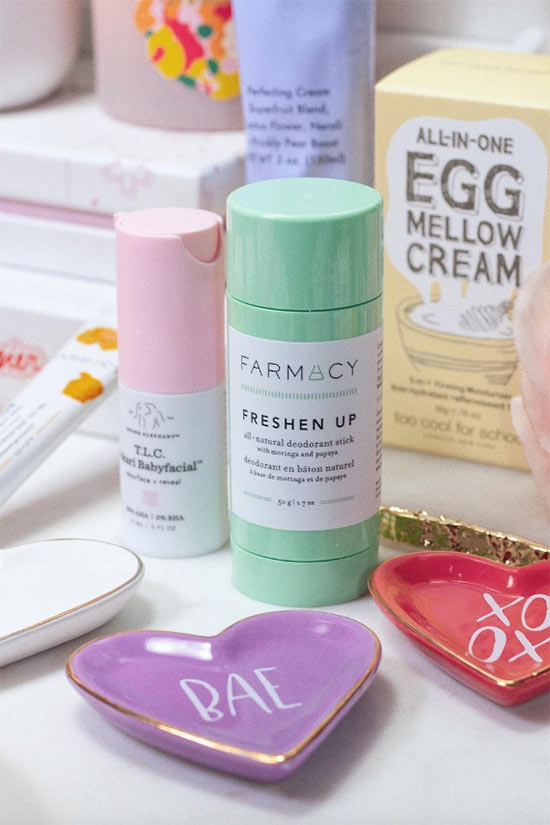
The greatest challenge when putting together a skincare routine for dry skin is the increased propensity to sensitivity and irritation that those with dry skin have. A product that might work beautifully for one person with dry skin could cause serious irritation for another. This is why I usually recommend products that are low on known irritants like alcohol, fragrances or essential oils.
It’s also why I stress being very careful with strong actives like chemical exfoliants, retinoids and vitamin C. It is better to use gentler versions of these ingredients and to introduce them into your skincare routine slowly.
Buffering is also a great way of using powerful actives. By buffering I mean applying them over an essence or moisturizer so that they take a little longer to penetrate into the skin. This way you can get the benefits the active ingredient has without the bad side effects.
Best Skincare Ingredients for Dry Skin
So what skincare ingredients should you look for in a product meant to mitigate dry skin? Keep these notes in mind!
• Skin Identical Ingredients
When your skin doesn’t produce enough sebum, it makes sense to counter the issue by introducing skin care that mimics sebum. Sebum is made up of lipids that include fatty acids (the main ingredients in oil), cholesterol, and ceramides. The best skincare products for dry skin will include all of them in the correct ratio, as they restore exactly what the skin lacks.
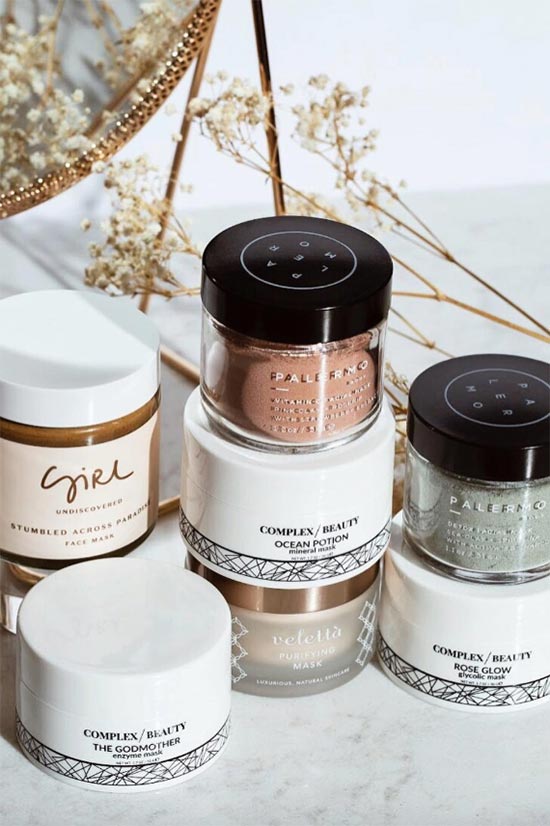
• Humectants
Everyone’s skin will benefit from humectants, the wondrous ingredients that are able to attract and hold water to then deliver it to the skin. Humectants are the best solution for dehydration, a condition that those with dry skin are particularly prone to having because they counter it pretty directly.
However, humectants can’t necessarily keep moisture in the skin for long, which is why if you have dry skin you need to lock them in either by using a formula that contains both humectants and occlusives or by following up a humectant-laden serum or essence with a heavier occlusive cream or balm.
There are many different humectants that show up in skin care, but the most common ones to look for are glycerin, butylene glycol, propylene glycol, hyaluronic acid (especially hydrolyzed or microencapsulated), and panthenol. Any molecule related to sugar will usually have some hydrating effects, as well, which is why honey is a popular natural ingredient and why sweeteners like xylitol and glucoside are becoming more popular skincare ingredients.
Probiotic ferment extracts are also having a rise, partially because of their ability to fortify the skin’s microbiome, but also because they have humectant effects once they come into contact with the skin. It’s important to note that these can exacerbate fungal skin issues, however. Serums and essences with probiotics are fabulous for those with dry or compromised skin as long as one doesn’t have any fungal skin issues.
• Occlusives
So what are occlusives, exactly? An occlusive is an impenetrable barrier through which water cannot pass. Occlusives, when applied towards the end of the skincare routine for dry skin, will prevent trans-epidermal water loss, which is just a complicated, science-y way of saying that they prevent moisture from evaporating from the skin.
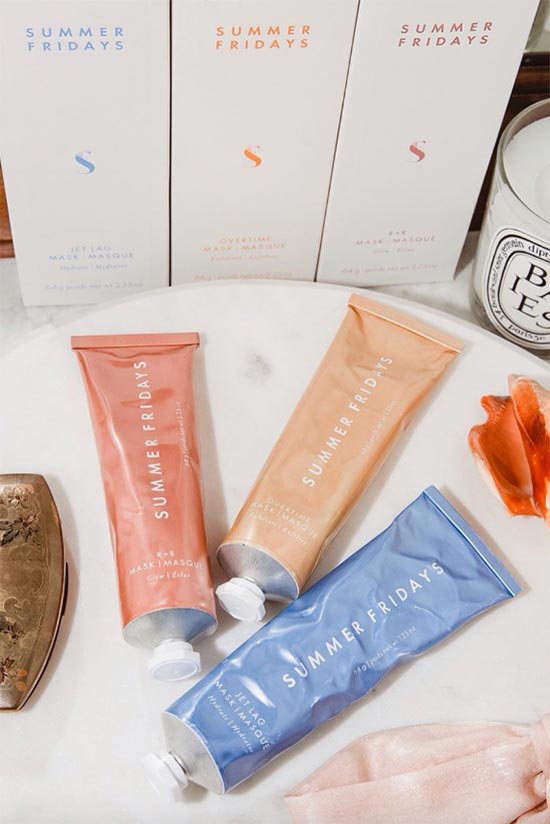
Almost all oils have some occlusive capabilities, but for total occlusion, the best ingredients are mineral oil, petroleum jelly, silicones, and lanolin, as they don’t allow any water to get out.
Part of the reason why sheet masks are so excellent for those with dry skin is that the sheet itself provides an occlusive effect. While the mask is on, absolutely no moisture is escaping, and all of the essence in the mask goes straight into the skin. However, once the mask is dry, it is no longer beneficial to the skin and should be removed.
• Exfoliants
Regular exfoliation is a good idea no matter your skin type, but it holds some specific benefits to those with dry skin. By removing that top layer of dead skin cells, you can ensure that moisturizing ingredients penetrate deeper into the stratum corneum and improve skin moisture levels. Exfoliation will also make your skin smoother to the touch, reduce flakiness and dry spots, and improve the luminosity of your skin.
The best exfoliants for those with dry skin are AHAs because they also have excellent humectant (moisture-binding) properties. Lactic acid and mandelic acid are particularly great exfoliants because they are gentle and less likely to cause irritation.
If your skin, despite being dry, is quite hearty then you can also try glycolic acid. If in addition to having dry skin you still suffer from acne you can also opt for salicylic acid, which exfoliates through oil, has a bacteria-inhibiting effect, and is better for unclogging pores.
• SPF
The damage caused by unprotected sun exposure is not to be scoffed at, and those with dry skin are particularly susceptible. Because dry skin is generally more prone to sensitivity and irritation, sunburns may be more painful and take longer to heal.
The other dangers of sun exposure, particularly skin cancer, apply to all skin types equally and should be taken very seriously. It’s also worth mentioning that sun exposure is the main non-genetic cause of skin aging, so if you’re even a little bit vain, then you should definitely load up on broad-spectrum SPF.
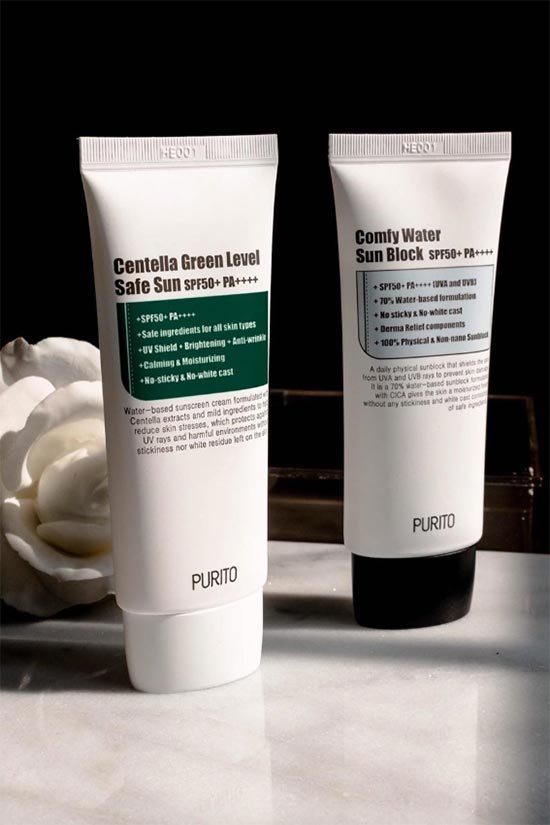
• Other Good Stuff
A skincare routine, even for someone with dry skin, often has more complex goals than just moisturization. Almost all of us would like to at least somewhat prevent photoaging (sun damage that leads to fine lines, hyperpigmentation, and loss of tone in the skin, a.k.a. non-genetic skin aging), so skin care rich in antioxidants is always a fabulous idea.
However, some commonly used anti-aging ingredients like retinol and ascorbic acid (a.k.a. vitamin C) can be a little harsh when one has delicate, dry skin. Using gentle versions of them, like magnesium ascorbyl phosphate instead of ascorbic acid or retinyl palmitate instead of retinol, will give you a weaker anti-aging effect but with the reduced risk of irritation.
Niacinamide is a great ingredient to choose, as, in addition to being a great antioxidant, it also helps reduce trans-epidermal water loss. At higher percentages it may also reduce oil production in the skin, so opt for formulas that only contain low amounts of it along with good moisturizing ingredients.
Some of us have more specific skin concerns. Those with dry skin will often also lean a little more towards sensitive, so they’ll require a skincare routine that is both moisturizing and anti-inflammatory, with soothing ingredients like allantoin, calendula, green tea extract, and centella asiatica.
Others might break out despite having dry skin, in which case non-drying acne treatments like low-percentage salicylic acid and retinol in oil or cream are the best remedies to try.
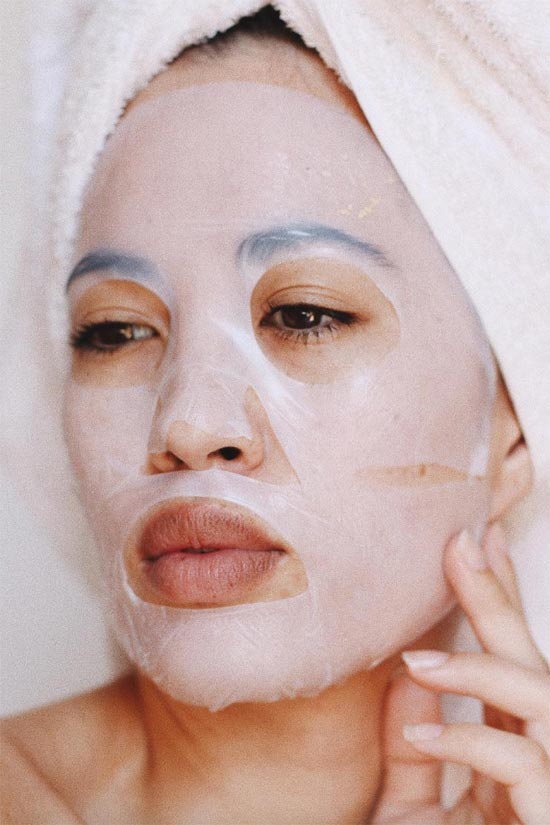
The Complete Morning Skincare Routine for Dry Skin
As you wake up, you should start taking care of your dry skin properly, following all of the steps presented below!
• Don’t Cleanse
Over-cleansing is one of the fastest ways to dehydrate and irritate dry skin. If your skin is dry, you’re not producing enough sebum at night to merit using a cleanser in the mornings. Instead, you can splash your face with water, wipe it with a damp face cloth, or use a cotton pad soaked in a hydrating toner or essence to remove minor debris.
• Essence or Hydrating Toner
Speaking of, essences are one of the best ways to start the hydration and moisturization process for those with dry skin. Essences, which are basically interchangeable with hydrating toners, are skincare products with a liquid texture that are primarily comprised of water and humectants, although they will often contain other soothing or anti-aging ingredients that are beneficial to the skin.
These products don’t contain any strong occlusives, and they are meant to penetrate into the skin quickly and to load it up with moisture. Essences are best applied directly to the skin, ideally with the help of a spray nozzle. If your essence doesn’t come in a spray bottle, you can decant a bit into your hands and then pat or tap it into the skin.
You can repeat this with a few different toners and essences, especially if you have a few with different ingredients, or you can do this a few times with the same essence to really maximize the amount of water your skin takes in.
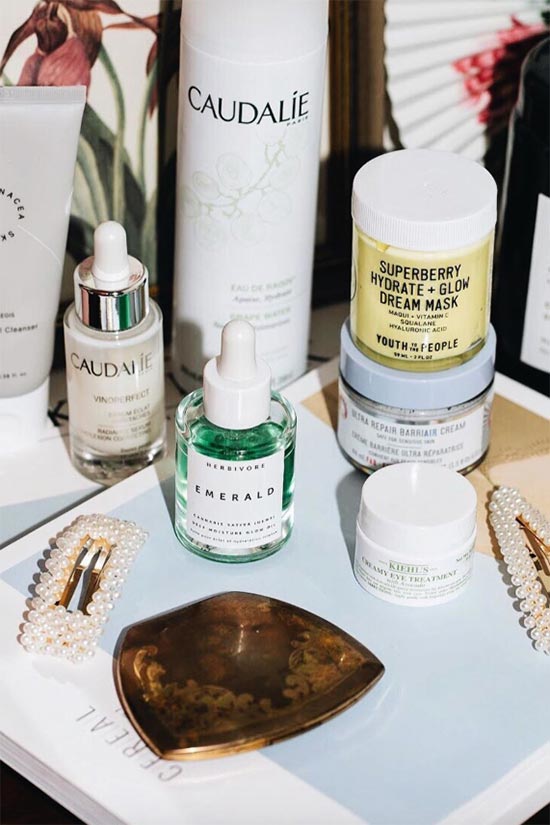
• Serums or Ampoules
A serum or ampoule is the next stage of layering moisture to allow it to thoroughly absorb into the skin. Serums are also made up of water and humectants, like essences, but they also tend to be a little thicker in texture and richer in particular active ingredients.
These ingredients can include potent antioxidants, skin resurfacers like vitamin A, chemical exfoliants, or specific skin soothers. You can choose to use the same serum in the morning and at night if it’s not too strong, or use one serum in the morning and another at night.
If your skin is fairly delicate it is better to dispense about a pea-sized amount of serum and to gently pat it into the skin without dragging or tagging. On the other hand, you might benefit from a gentle massage using circular, upward motions, which will help with blood circulation under the skin.
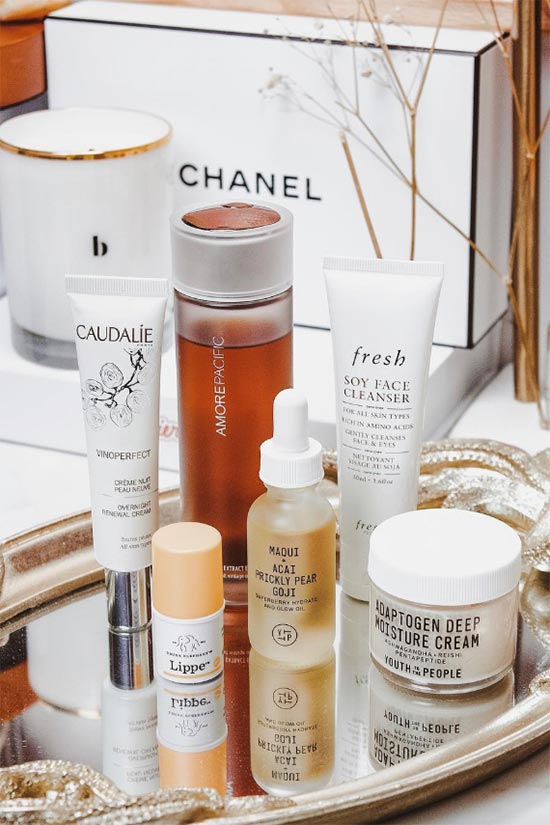
• Eye Care
You can use most serums and moisturizers around the eyes without issue, as long as they don’t contain high levels of retinoids, vitamin C, or chemical exfoliants. However, if you have particular concerns around your eyes you might want to use a specific eye care product that will treat those concerns.
The best way to apply products around the eyes is with extreme gentleness. Dispense a tiny amount of your cream or serum to the tip of your ring finger, and then transfer a bit to the ring finger on the other hand. Dot the product under the eye, starting near the inner corner and working your way out. Then, from the outside in, dot the product along the orbital bone. The skin around the eyes is very sensitive, so avoid rubbing or tugging.
• Moisturizer
A moisturizer is a must-have when your skin is dry. You can choose to use a moisturizer with an SPF or a sunscreen that has moisturizing properties (especially if your routine also includes a hydrating essence or serum), or you can choose to use both a moisturizer and a sunscreen.
Moisturizers are important because, unlike essences and serums, they contain high amounts of occlusives and emollients – the ingredients that make up for your lack of sebum by filling in the gaps between the dead skin cells and locking in moisture.
There isn’t a specific amount of moisturizer that is correct to use. If your skin is very dry and dehydrated, you will likely need more, while if you have been following a nourishing skincare routine for dry skin for a while then you won’t need as much.
Start off with a pea-sized amount, and massage it into your skin in gentle, circular motions from the bottom up and from the inside of the face outwards. If most of the product sinks into your skin quickly then apply more.
If you’re also relying on your moisturizer for sun protection, then please apply it as instructed in the next bullet point.

• Sunscreen
I’ve already explained why sunscreen is so critical, especially for those with dry skin. When it comes to sunscreen there is no playing around – we must use at least a ¼ teaspoon of product to cover the average face.
If you’ve already applied moisturizer or any other skincare product, then wait a few minutes to ensure they fully sink in to your skin, since you don’t want anything to dilute the protection of your sunscreen.
You may find that you can apply the full amount of sunscreen in one go, although if it seems like too much product then apply it in two layers of ⅛ teaspoon, waiting a few minutes in between. Apply your sunscreen in an upward massage, much as you would a moisturizer. Wait a few minutes to allow the sunscreen to settle before applying any makeup to your dry skin.
The Complete Night Skincare Routine for Dry Skin
Your complete skincare routine for dry skin should end with the following steps:
• Cleanse
Cleansing can be the most irritating and drying skincare step, but it doesn’t have to be if you use an ultra-creamy and moisturizing cleanser. If you wear makeup in your day-to-day life, then you will possibly want to do a double cleanse, starting with oil or balm cleansers that will totally break down makeup and sunscreen, as well as other impurities that are easier to remove.
Oily cleansers should be applied to the skin while it is dry, massaged in for a bit, emulsified with water, and then rinsed or wiped away.
Depending on how your skin responds, this might be enough, but if you feel like your oil or balm cleanser has left behind a bit of a residue, you can do a second cleanse with a milk cleanser, which you also apply, massage in, and then rinse or wipe away with a damp cloth.
Make sure to avoid foam or gel cleansers, as these tend to be too stripping for dry skin.
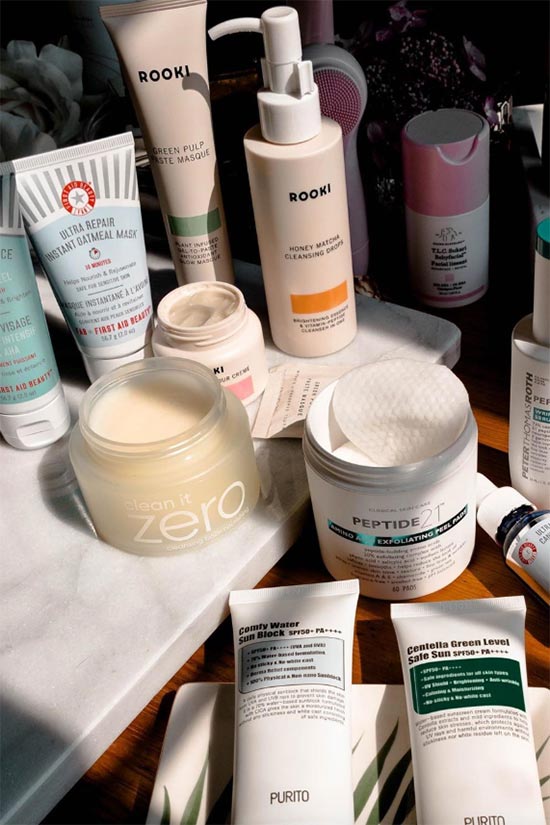
• Toner or Essence
A hydrating toner or essence is a great way of loading the skin up with moisture, especially if the rest of your evening dry skincare routine is mostly made up of occlusive creams (or just one occlusive moisturizer – that’s okay, too). Much like in the morning, you want to apply your hydrating liquid-based product by splashing it on your face or by misting it on.
• Exfoliants and pH-Dependent Treatments
Your nighttime routine is the best time to use chemical exfoliants, which can come in the form of toner, serum, or even lotion.
Chemical exfoliants, as well as products with ascorbic acid (a version of vitamin C that is pH-dependent) are best applied towards the beginning of your routine, before you’ve applied any products that contain occlusives, since they need to come into close contact with the skin and before any products that might increase your skin’s pH have been applied.
You should apply your pH-dependent products based on their formula – toners should be splashed on the face, while serums can be pressed or massaged in.
• Serum
In the evening a serum can be your chance to just give your skin yet another layer of moisturization that is a little thicker than an essence or toner but is thinner than a moisturizer. Serums are also great for fortifying the skin with all kinds of antioxidants, anti-inflammatories, skin brighteners, or other anti-aging compounds. That’s like in the morning you want to apply your serum either with a gentle pressing motion if you’re more prone to sensitivity or with a slightly more invigorating massage.
• Eye Care
Once again, for eye care you can choose between your gentle face products or dedicated eye creams and serums. Like in the morning, you want to apply your products gently, by pressing them in with your ring finger.
• Treatment Oil
Light botanical oils load the skin up with fatty acids and antioxidants, without overly occluding the skin. They are a great way of adding some extra nourishment to the skin before a moisturizer, especially if you find that your moisturizer is a little too light. Smooth your facial oil on as you would a serum, opting for a small, dime-sized amount.

• Moisturizer
Apply your moisturizer of choice as you would in the morning. If you use a moisturizer that has an SPF in the mornings then you will want to use a dedicated night cream that does not offer sun protection at night.
Evening is the best time to use a moisturizer with skin-identical ingredients, as those tend to be a little heavy and potentially too greasy in texture for daytime use. Apply your moisturizer with the same gentle massage you would utilize for your daytime application.
• Buffered Treatments
When talking about buffered treatments, I refer to either medicinal acne treatments like benzoyl peroxide or stronger retinoids. These strong actives are optional, and may be used if you suffer from acne despite having dry skin, or if you’d like a strong age prevention product.
Since those with dry skin are more prone to sensitivity it’s important to be careful with such strong actives. A great way of getting all the benefits of a powerful anti-acne or anti-aging treatment without any of the drying or irritating side effect is to make it a little harder for the product to penetrate into the skin.
By applying it after you’ve applied your moisturizer you can slow down the rate of penetration and decrease the chances that the product will irritate or dry your skin. You can also experiment with applying these products after a slightly thicker serum but before moisturizer.
• Occlusive Balm
A final occlusive step at night can be the best way to seal all of the essences, serums, and moisturizers into your skin. It is possible that your nighttime moisturizer is occlusive enough, but if it’s not or if you’d like an extra boost, follow it up with a thin layer of a balm or night cream that is rich in one of the occlusive ingredients I mentioned earlier, like petrolatum, mineral oil, lanolin, or dimethicone.
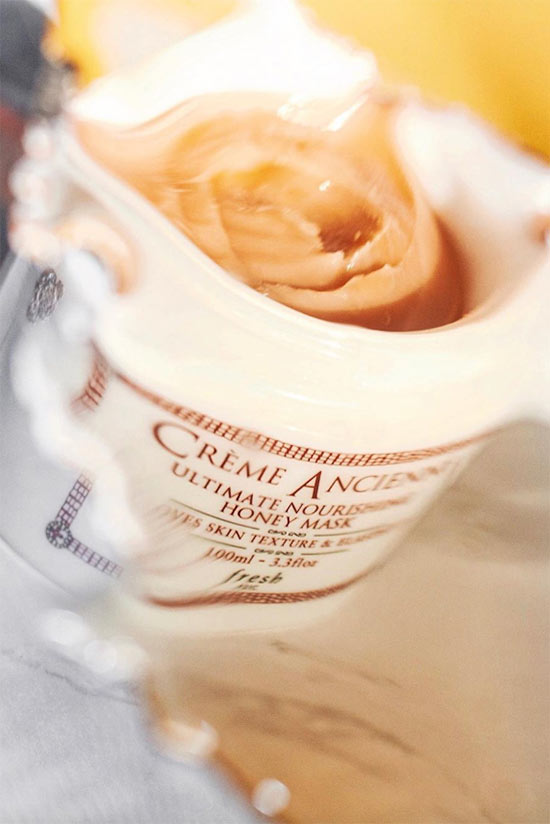
Weekly Skincare Routine for Dry Skin
Once a week or so it is great to take a moment and truly pamper yourself, and also give your dry skin a deeper moisturizing treatment. You can do it in the morning or at night, by simply working a mask into your typical skincare routine for dry skin.
• Cleanse
Before masking it’s important that the skin be clean. If you’re masking in the daytime, then a quick cleansing with a milk cleanser should be enough, but if you’re masking in the evening then follow your full cleansing regimen.
• Nourishing Mask
Once your skin is cleansed, you can apply your moisturizing mask. Sheet masks are particularly great for those with dry skin because the sheet itself acts as an occlusive and ensures a maximum amount of product penetrates into the skin. That being said, any creamy skincare mask that does not contain clay or charcoal is going to be fabulous.
Different masks should be applied differently. Sheet masks need to be smoothed over the skin and left on for as long as it takes them to become dry – this can be as long as one hour. You can apply a sheet mask over clean skin or you can apply it after toner or essence. Once enough time has elapsed, you simply remove the mask and then continue on with your skin care without rinsing or removing anything.
Cream masks are best applied to clean skin, either with the hands much like you would apply a moisturizer or with the help of a mask brush. These kinds of masks should be left on between 15 minutes and half an hour. When it’s time to remove your mask, simply rinse it away with cool water or wipe it off with a damp face cloth.

• Rest of Skin Care
After masking finish off your dry skincare routine as you normally would. Apply your usual essences, serums or moisturizers, and if it’s daytime then don’t forget sunscreen.
Photos via @nikki.cruz, Instagram

